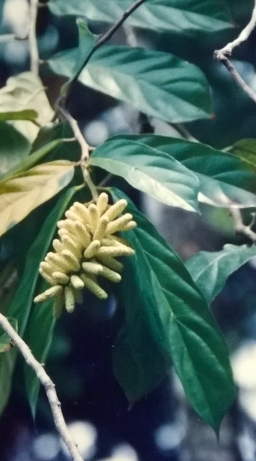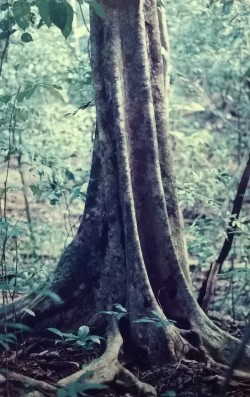Tetrathylacium johansenii Standley
Tree: Common subcanopy, or occasionally canopy, evergreen tree (20-25m) notable for its unusual off-white bark, distinctively elongated leaves, and grape-shaped fruits.
Description: This tree has a very irregular though straight trunk (40 cm). It is contoured by vertically running ridges or folds that become more pronounced as they near the tree’s base, ending as low buttress roots.  The bark is off-white and mostly smooth, though close inspection reveals that it is shallowly etched by a scalloped or pockmarked pattern. Frequently, suckers can be found growing out of the basal portion of the trunk. Composed of thin and flexible branches, Tetrathylacium crowns, are thick, tall and narrow. Leaves are simple, alternate, dark green and glossy. They are much longer than they are wide (about 23 cm by 5 cm) and thus have a narrow, finger-like appearance. Most blades actually get slightly wider toward their distal ends – an uncommon leaf characteristic useful in field identification – and they end in long drip-tips. A percentage of the old foliage turns yellow, falls, and is replaced at periodic intervals during the year. Fresh, expanding foliage is supple, translucent, and red. Tetrathylacium has very unusual flowers. Appearing in large terminal panicles, each blossom is white and shaped like small, rectangular prism, measuring 4 mm on a face. About 50 of these structures are packed tightly – puzzle fashion – onto a 4 cm long rod and about 25 or 30 or these rods make up a typical inflorescence. The weight and terminal position of these flowers usually causes them to dangle from the ends of the supporting branches. Flowers seem to occur sporadically and frequently during all months except July, August, and September and there appears to be little or no consistency in the timing of this activity between years. Finally, the fruits are borne massively in very large, and heavy bunches. Each is a green globular structure measuring 1-1.5 cm in diameter and containing about 50 very small (<1 mm) brown seeds. The fruits smell of petroleum or some organic solvent and quickly brown
The bark is off-white and mostly smooth, though close inspection reveals that it is shallowly etched by a scalloped or pockmarked pattern. Frequently, suckers can be found growing out of the basal portion of the trunk. Composed of thin and flexible branches, Tetrathylacium crowns, are thick, tall and narrow. Leaves are simple, alternate, dark green and glossy. They are much longer than they are wide (about 23 cm by 5 cm) and thus have a narrow, finger-like appearance. Most blades actually get slightly wider toward their distal ends – an uncommon leaf characteristic useful in field identification – and they end in long drip-tips. A percentage of the old foliage turns yellow, falls, and is replaced at periodic intervals during the year. Fresh, expanding foliage is supple, translucent, and red. Tetrathylacium has very unusual flowers. Appearing in large terminal panicles, each blossom is white and shaped like small, rectangular prism, measuring 4 mm on a face. About 50 of these structures are packed tightly – puzzle fashion – onto a 4 cm long rod and about 25 or 30 or these rods make up a typical inflorescence. The weight and terminal position of these flowers usually causes them to dangle from the ends of the supporting branches. Flowers seem to occur sporadically and frequently during all months except July, August, and September and there appears to be little or no consistency in the timing of this activity between years. Finally, the fruits are borne massively in very large, and heavy bunches. Each is a green globular structure measuring 1-1.5 cm in diameter and containing about 50 very small (<1 mm) brown seeds. The fruits smell of petroleum or some organic solvent and quickly brown inside when cut and exposed to the air. Due to its size, color and configuration, the fruit cluster strongly resembles a bunch of green grapes. These clusters often add so much weight to tree limbs that they are broken during heavy harvests. Fruition takes place during frequent but sporadic intervals during all months except August through November. There does appear to be a peak in fruit production in June and July.
inside when cut and exposed to the air. Due to its size, color and configuration, the fruit cluster strongly resembles a bunch of green grapes. These clusters often add so much weight to tree limbs that they are broken during heavy harvests. Fruition takes place during frequent but sporadic intervals during all months except August through November. There does appear to be a peak in fruit production in June and July.
Similar Species: The Sonzapote tree, Licania platypus, has similar, finger-like, deep green foliage. However, this much larger tree’s leaves are substantially longer and thicker than Tetrathylacium‘s and they lack drip tips. It is rare to see Tetrathylacium without some sort of fertility and, when present, the fruits or flowers of this species are unique and identifying.
Natural History: Tetrathylacium leaves possess well developed, even stereotypical, “drip tips”. In the formation of these structures, the otherwise relatively obtuse distal end of the blade is modified into a slow-tapering, sharp point measuring about 1.5 cm in length. These projections, or drip-tips, aid leaves in the process of water removal from their surfaces by decreasing the amount of the blade in contact with the water droplets as they move toward the leaf tip. This, in turn, decreases the total force of adhesion that exists between the water droplet and the blade, allowing the droplet to be pulled off by the force of gravity while still relatively small in size.
By shedding water more rapidly, drip-tips enable foliage to remain dryer during and after rainstorms. This diminishes the excess weight supported by tree limbs at any one time during a storm – and thus reduces the risk of limb breakage. It also helps to ward off fungal parasites – organisms that thrive in regions of high humidity. Finally, the time during which leaf surfaces remain reflective and wet is kept to a minimum, allowing increased absorption of sunlight – and helping plants in the dark forest understory trap the solar insolation that they require.
It also helps to ward off fungal parasites – organisms that thrive in regions of high humidity. Finally, the time during which leaf surfaces remain reflective and wet is kept to a minimum, allowing increased absorption of sunlight – and helping plants in the dark forest understory trap the solar insolation that they require.
Tetrathylacium flowers are pollinated by bees and other insects. Fruits are consumed and seeds dispersed by a large variety of arboreal forest mammals – including coatis, tayras, and squirrel monkeys. Croat (1978) indicates that bats play a role here as well.
Distribution: Tetrathylacium is a component of the primary forest. The species along the central Pacific slope. It ranges from Costa Rica to Colombia.
